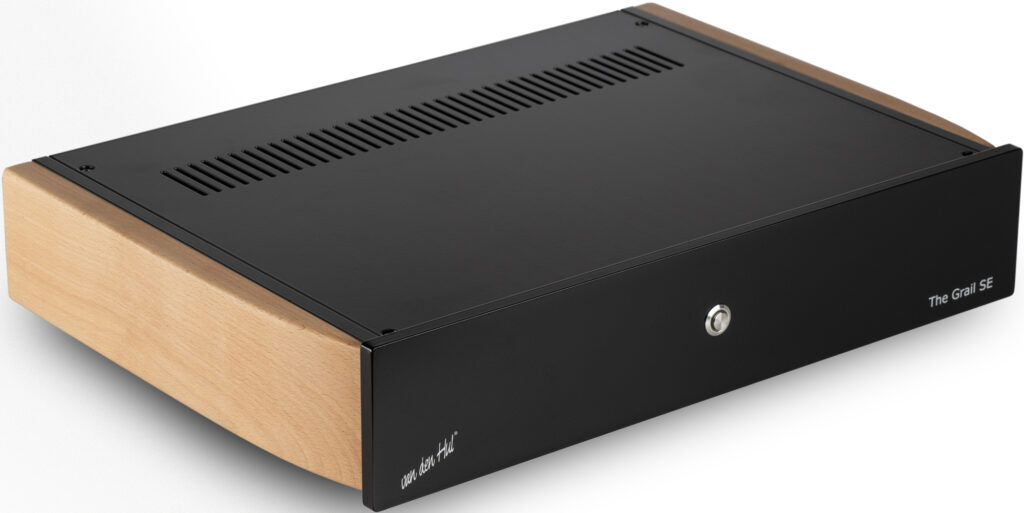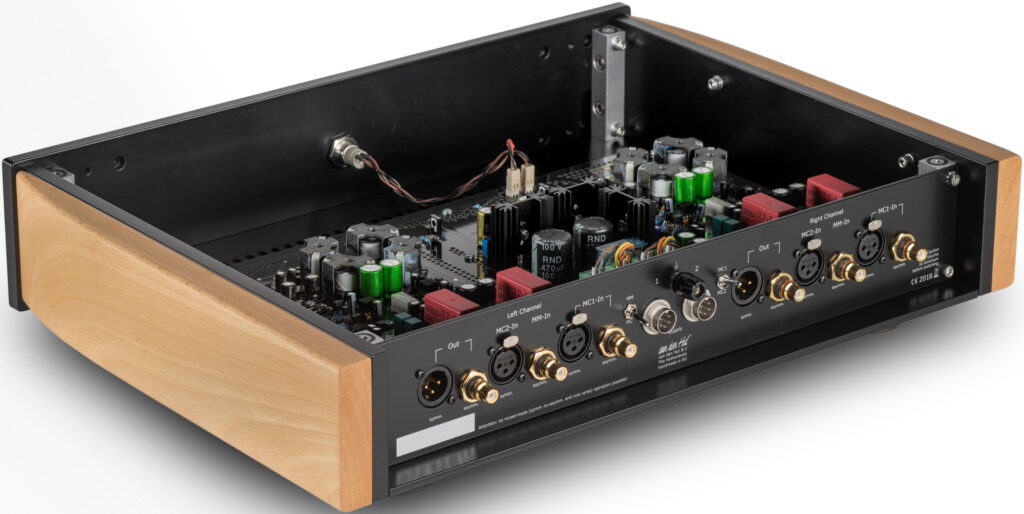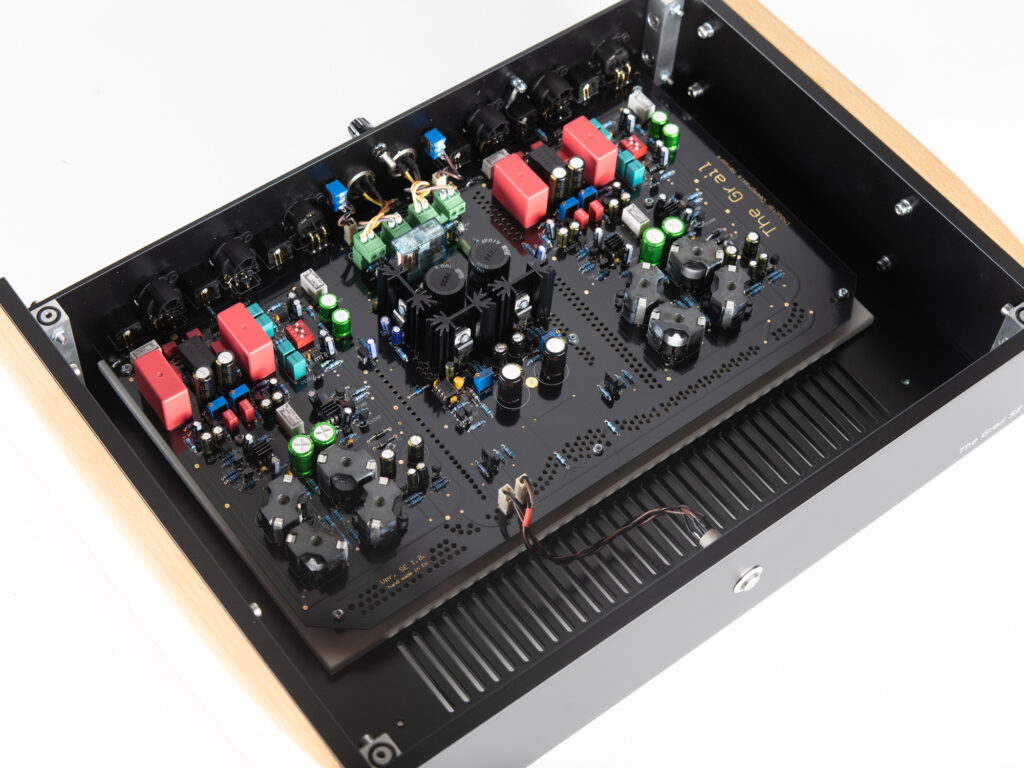As a cartridge manufacturer is in the best position theoretically to create a perfectly matched phono preamp for its best cartridges, so it becomes a cause for celebration whenever good phono preamps actually emerge from cartridge makers themselves. The Pass Laboratories Xs Phono is the best phono preamplification system I have yet experienced, costing $48,000 and comes in two large chassis. The Van den Hul The Grail SE is the second costliest I have auditioned, and it from the cartridge maker itself.
While the VdH cartridges are distributed by VPI Industries, distribution of the Van den Hul electronics is handled by John McGurk of Audioshield Audio Distribution. On the flagship model in the company’s lineup of phono preamplifiers, John offers the following:
“The Grail has a different lay-out where the current supplied by the cartridge is taken as the input-signal. With some (proprietary process), we are free from any cartridge-load problem. Changing a cartridge means that automatically the best load is taken. This is always the resistive load and not the capacitive.
Only with high impedance coils, the capacitive load starts to be interesting. But with MC cartridges with micro-Henry inductance, the load capacitance starts to be influential far over 100 KHz. Better is to focus on cartridges where such drastic steps are not necessary. What means that the basic resonance frequency of the cartridge should be over 50 KHz.”
Van den Hul engineer Jurgen Ultee further elaborated in the following:
“A transformer coupled MC input stage (regardless if it is a transformer from Lundahl, Jensen, Kondo or whatever) does not make an automatic matching to the MC cartridge.About proper loading of a cartridge, Lundahl recommends on their website, and the following paper from Kandaudio, both show that a proper resistor has to be chosen for correct impedance matching. There is nothing wrong with this method, but it is by no means an automatic function. Despite of this, some manufacturers claim that their MC preamps with input transformers are “auto-tuning” the load impedance. Some companies like e.g. WLM with their Phonata MC preamp used an input transformer as a kind of current sink. This does not deliver a constant resistive value over the frequency range – but this is mandatory to achieve a good frequency response.
The Grail uses no transformer but an active input stage, distantly related to a Satri circuit. No additional matching resistor is necessary. Due to the bandwidth limiting behaviour of a transformer we prefer active circuits, that do much less bandwidth limiting and phase distortion. Additionally, the impedance plot is almost fully resistive over the entire audio band. You can’t do this with transformers, except some very, very expensive ones like the Kondo. It is definitely really good but at super high costs; in fact a pair of these transformers is more costly than The Grail itself.”
Comprising one full size main chassis for the electronics and one half size power supply chassis, The Grail SE was easier on placement than the Xs Phono, though imminently heavy at thirty-plus pounds. Specified at 73 dB of maximum gain, The Grail SE’s highest output was thus lower than that of the Xs Phono at 76 dB, requiring turning up the output of the Xs Preamp to minus 04.0 most of the time, whereas minus 12.0 would suffice in the case of the Xs Phono.
With The Grail SE, The Colibri XGW Master Signature cartridge presented perhaps the most original VdH sound. The instrument groups in the Angel Direct Metal Master issue of the 1984 Riccardo Muti digital recording of the Tchaikovsky Swan Lake and Sleeping Beauty suites was reproduced in perhaps the most spot-on compared to other phono preamps, sounding pronounced, well formed and full of sparkle. The tambourine, in particular, had such beauty of tone and energy it made me marvel at its real, unfettered, matter-of-fact presence.
The Grail SE’s background noise was non-existent, akin to that of the Xs Phono. But since The Grail SE lacks adjustable settings for the user, it precluded possibility of a more personalized tonal balance, when I could scale back the resistive loading on the Xs Phono, say from 1K to 320 and get more upper midrange sparkle from The Colibri. My only option was to increase the “Brilliance” of the Sound Lab panels, and dialing it back when using the Esoteric K-01XD SACD player. The process was easy as to render the argument moot.
Over time, the more I listened to it, the more I felt secure in trusting The Grail SE as I would with the Xs Phono. I went through a considerable number of LPs to ascertain my comfort and trust level in the phono stage.
There are moments when The Grail produced arguably one of the most accurate representations of the RIAA curve in records. For instance, “Ave Maria Guarani” from silver screen legendary composer Ennio Morricone’s The Mission soundtrack aims to depict a disparate choir the members of which are recently converted villagers, and The Grail isolated the voices masterfully without sounding overly harsh. Some may even say there is a fleeting sweetness from the phono preamp, most conducive towards music enjoyment, resembling results obtained on The Colibri XGW Master Signature cartridge from the higher resistive settings on the Pass Labs Xs Phono. Moments such as these convince me of the status of The Grail as an high-end auto-adjusting phono stage.
The most natural and accurate vinyl sound is probably what The Grail SE is all about, but one of the most impressive feats of the phono stage was when it rendered the bottom-end to upper bass region of 20 Hz to 100 Hz with comparable speed, tightness and definition as the Xs Phono. In fact, it was precisely the range immediately above this region to the lower midrange that the Van den Hul conceded to the Pass Labs, where cellos, trombones, classical piano solos and even electric basses were less defined and clear. The glory that is the Pass Labs in amplifying the feeble cartridge signal from the hard rock band Asia on its debut album of the eighties was undisputed, providing for a supreme experience. Still, the Van den Hul continued to surpass several other expensive phono preamps in dynamic contrast, extension, separation and most of all, bottom-end force and resolution.
The most stunning change that The Grail SE brought to the sound of The Colibri was the strengthening of the spatiality of venue and the naturalness in mannerism in which it was achieved.
For instance, The Colibri and The Grail SE sounded just right with some Deutsche Grammophon records, sounding not just relaxed and atmospheric with the Karajan Adagio LP of the seventies, while also extended and three-dimensional, dynamically expedient and expansive in the conductor’s last recording cycle of the Beethoven Symphonies in digital. Both under the same label, the experience demonstrated The Grail SE’s ability to not only depict distinct tonal and textural characteristic of the changing recording and mixing techniques, but also spread out activities on stage orderly. Advanced cartridge engineering may not be able to mitigate obsolete recording technologies, but the Van den Hul system consistently pulled the best sound out of the groove.
The aforementioned Barbra Streisand album proved its place in my collection as the VdH system completely tracked every audible nuance and ambience in the most confidential and darn near consciously unnoticeable manner. The cartridge sounded more engaging with the Pass Labs Xs Phono on a conscious level, but the VdH combination presented an indisputable case on the naturalness of the system.
Also true in this instance is that The Grail sounded like a 750 Ohms setting on the Xs Phono that I crave but doesn’t really exist as the phono preamp jumps from 500 to 1K with no stopover in between. Still, the common trait of phono stages such as The Grail SE and the Xs Phono is the unmistakable and unforgettable forward momentum and catapulting force.
Conclusion
There were occasions when I would love for The Grail SE to impart a wee bit extra top-end, an indulgence which the $48,000 Pass Labs Xs Phono accorded with its user-adjusted resistive loading, and I have found Van den Hul’s approach and measures in its fastidious designs an equal to the Xs Phono in spatiality at the minimum. The Grail SE was as three-dimensional and ambience savvy as the Xs Phono; but where the Xs Phono accorded the user with flexibility and customized listening preferences, the Grail SE focused instead on unflinching consistency.
In the end, an analog sound system is but an extension of the phono cartridge, and it sets the standard of the system’s caliber. We can upgrade the turntable, the tonearm, the cabling or the phono stage but all the demonstration class electronics downstream can achieve is what the cartridge giveth. The Colibri XGW Master Signature is quite peerless at its price range.
In this advanced digital audio age, vinyl playback via The Colibri XGW Master Signature as amplified by the Van den Hul The Grail SE continued to present the most definitive level of performance, propelling analog playback to reign supreme. There are things that complete us as audiophiles. Add the Van den Hul system to the list.
Review system:
PS Audio DirectStream Power Plant 20 AC regenerator
Acoustic Sciences Corporation TubeTraps
Audio Reference Technology Analysts EVO interconnects, power cable
Audio Reference Technology Analysts SE interconnects, power cables
Audio Reference Technology Super SE interconnects, power cables
Clearaudio Master Innovation turntable system with Smart 24 power supply
AMG 12J2 tonearm
Stealth Audio Design Helios phono cable
Pass Laboratories Xs Phono
Pass Laboratories Xs Preamp
Pass Laboratories XA200.8 pure class A monoblocks
Bricasti Design M28 class AB monoblocks
Sound Lab Majestic 645 electrostatic panels
Copy editor: Dan Rubin
- ← Previous page
- (Page 2 of 2)



